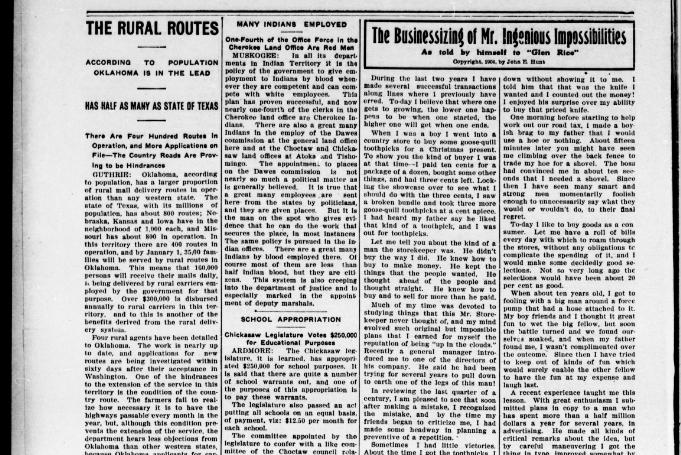|
Moderated by NW Okie! |
Volume 14 , Issue 442012Weekly eZine: (366 subscribers)Subscribe | Unsubscribe Using Desktop... |
1904 November - The Muskogee Cimeter News

When I was researching Chronicling America Historic American newspapers in Oklahoma, I came across The Muskogee Cimeter, dated 17 November 1904, page eight, with the following headlines: "Many Indians Employed." The subheadlines were: "One-Fourth of the Office Force in the Cherokee Land Office Are Red Men."
Muskogee -- In all its departments in Indian Territory it was the policy of the government to give employment to Indians by blood whenever they were competent and could compete with white employees. They also reported that this plan had proven successful, and nearly one-fourth of the clerks in the Cherokee land office were Cherokee Indians. There were also a great many Indians in the employ of the Dawes Commission at the general land office, and at the Choctaw and Chickasaw land offices at Atoka and Tishomingo.
The appointment to places on the Dawes Commission was not nearly so much a political matter as was generally believed. It was true that a great many employees were sent there from states by politicians, and they were given places. It was the man on the spot who gave evidence that he could do the work that secured the place, in most instances, is what the article stated in 1904. The same policy was pursued in the Indian offices.
There were a great many Indians by blood employed, and most of them were less than half Indian blood, but they were citizens. This system was also creeping into the department of justice and was especially marked in the appointment of deputy marshals.
School Appropriation
The Chickasaw Legislature Voted $250,000 for Educational Purposes was the sub-headlines of School Appropriation we find via an Ardmore newspaper (printed in the Muskogee Cimeter) back then. The Chickasaw legislature had appropriated $250,000 for school purposes. It was said that there were quite a number of school warrants out, and one of the purposes of this appropriation was to pay these warrants.
The legislature also passed an act putting all schools on an equal basis of payment ($12.50 per month for each school).
The committee appointed by the legislature to confer with a like committee of the Choctaw council relative to the affairs of the nation made a lengthy report recommending a plan of settlement, which was adopted by the legislature. Both nations would make an itemized account of the finances and settle accordingly, the Chickasaws to receive one-fourth and the Choctaws three-fourths of the money.
Talihina's Disastrous Fire
Did you know that in November, 1904, that half of the Indian Territory Town, Talihina, went up in smoke? This article traveled by way of Paris, Texas to the Muskogee Cimeter where we learned that word was brought here by a train crew of the big fire which wiped out the entire west side of the town of Talihina, situated about one hundred miles north. They reported that this section of the town contained a number of business houses, two hotels, the Frisco depot and section house and other improvements, all of which, with the exception of the Frisco coal shed and water tank, were totally destroyed.
The rails were so badly warped by the heat that it was impossible to run the train over them, and it was found necessary to lay a section of new track before the train could proceed. The fire was supposed to have originated in a grocery store.
Want New State To Be Dry
Another little tidbit of the Muskogee Cimeter, November, 1904, mentions the movement for prohibition in Indian Territory, after it is admitted to statehood. Hundreds of petitions had been secured from every town and hamlet in Indian Territory asking for prohibition. Congress would be flooded with these. The Rev. Mr. Sweet was at the head of the prohibitory movement, and had prepared communications requesting the people of every state to write to their congressmen and senators, asking them to vote for no statehood bill which does not contain a prohibitory clause.
| View or Add Comments (0 Comments)
| Receive
updates ( subscribers) |
Unsubscribe
| © . Linda Mcgill Wagner - began © 1999 Contact Me | |
